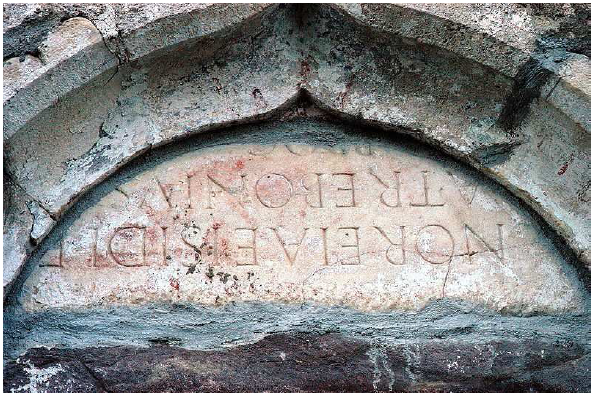d) Noreia (‘the Courageous One’) and Veica (‘Combat’) (Austria)
It is worth mentioning the goddess Noreia, who is known from several dedications discovered in today’s Austria and Slovenia, even though the Celticity of her name is dubious and her cult is confined to Romanized Noricans, working for the province, imperial officials and soldiers.1574 Her worship was actually part of conventional Roman worship. In the centre of Celeia was discovered an inscription associating Noreia with Celeia (‘the All Powerful’), the eponymous goddess of the city, and Iupiter Optimus Maximus, the head of the Roman pantheon and of the Capitoline Triad, composed of Juno and Minerva, generally honoured by the army: IOM et Cel(eiae) et Noreiae sanct(a)e, ‘To IOM and Celeia and sacred Noeia’.1575 On another monument from Celeia, she is mentioned together with Mars, Hercules and Victoria.1576 From the territory of Celeia, at Atrans and Črešnjevec, come two other inscriptions mentioning her.1577 She was also venerated at the sanctuary of Hohenstein (Austria), situated on the River Glen, in six dedications, one of which equates her with the Egyptian goddess Isis.1578 Another inscription discovered at Ulrichsberg (Austria), probably brought from Hohenstein, mentions a sanctuary erected in honour of Noreia Isis (fig. 34).1579 Finally, she is honoured twice in Weihmörting, near Boiodurum.1580

It is difficult to determine whether her name is Celtic or pre-Celtic.1581 De Bernardo Stempel proposes to break down her name as *nor-icī and to translates it ‘the powerful, vigorous, strong or courageous one’.1582 If this etymology* is correct, the goddess Noreica might have originally been a protective goddess, possessing martial aspects and embodying courage at war and strength in battle. This could explain how she later personified and protected the province and its institutions.1583
Interestingly, a lost dedication of unidentified origin mentions a goddess Veica Noriceia: Veicae Noriceiae A. Poblicius D. l. A[---] P. Postumius P. l. Pau(...) coir(averunt).1584 The inscription indicates that the two dedicators had a sanctuary erected in honour of the goddess (coiraverunt). The divine name Veica is most certainly Celtic1585 and can be broken down as *weik-ā, that is ‘the one of the battle’,1586 from an IE root *weik meaning ‘to vanquish’ and denoting “the ideas of both battle and wonder-working” according to M. York - it can be related to Irish fíoch, ‘ferocity’.1587. In view of this etymology*, it can be suggested that Veica is a war-goddess embodying and presiding over the fighting.